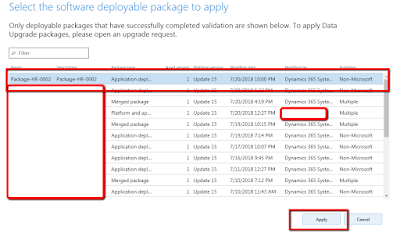Process Data packages
Following are the steps to create Process data packages using LCS and apply to your environment.
Step-1 Navigate to Data Management Workspace and click on Export Tile.
Reference screenshot
Step-2 select any entity and export the data in Excel. Which we will use in the next step. then click on download the package.
Reference screenshot
Step-3 Now login to LCS and navigate to Assets library and click on the data packages Tab.
Step-4 Add the New data package and upload the package. which we downloaded in step-2.
Reference screenshot
Step-5 Now click on Process Data Packages and click on the + icon to add a new PDP.
Step-6 Pre-requisite Business Process required to create Process Data Package.
Step-7 Click on + Icon to add Process data packages. Popup will appear fill out the required fields and click on confirm.
Reference screenshot
Step-8 New screen will appear in 3 to 4 seconds.
Step-9 Select the business process (Step-6) and click on Next.
Reference screenshot
Step-10 Now click on select data packages and select your required package from the popup and click confirm.
Reference screenshot
Step-11 Add the package dependency if any. in my case there is no dependency. so I skipped this step and click on next for the last step of this wizard.
Reference screenshot
Step-12 Now select your business process and click on data packages and save the complete process.
Reference screenshot
Step-13 Navigate to the Assets library again and click on the Process data packages Tab.
Step-14 Select your required Process and click on consume icon.
Reference screenshot
Step-15 Click on consume new process data packages.
Reference screenshot
Step-16 fill the required fields like the below screenshot and click on Create.
Reference screenshot
Step-17 Now click on newly created records to open the PDP in the new window.
Reference screenshot
Step-18 New window has 3 following steps.
- Review
- Review & Approval
- Apply Data package.
Step-19 select the process node and Mark process as reviewed. In my case, I have marked the complete process as reviewed.
Reference screenshot
Step-20 On the 2nd step mark as approved this operation will navigate to you on the new screen.
Step-21 Click on approve icon to change the status from Not Started to Approve
Reference screenshot
Step-21 If you want to change the data package click on upload data package else skip this step.
Reference screenshot
Step-22 Click on Apply icon to start the process. To perform this activity you should have Admin (tenant user on) your desired environment.
Step-23 Select the company from the popup and click on apply.
Reference screenshot
Step-24 Once the process starts, it will change the status to in-progress then complete if everything works fine.
Reference screenshot
Please feel free to contact me if you are facing any issues during the implementation of this blog.



























































